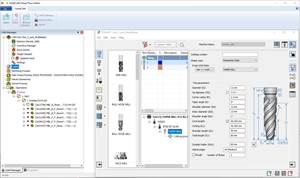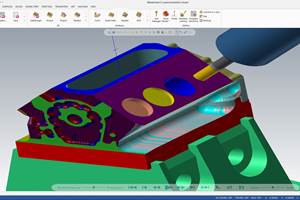An Affordable, Secure Way To Exchange 3D CAD Models
Shops no longer need 3D CAD software to view 3D CAD models.
If you use a computer, then you’ve likely viewed PDF files. You may have even created some. What you may not know is that these secure, albeit easily shared electronic documents may soon play a more prominent role in the way designers and machine shops collaborate to speed new products to market.
The Portable Document Format (PDF) file system, developed by Adobe Systems Incorporated (San Jose, California), takes documents created in any number of software packages and converts them into a format that can be viewed without the original software. Adobe Acrobat generates PDF files. The free Adobe Reader, installed on nearly every computer sold today, allows users to view these files.
Acrobat 3D is the latest version of Adobe’s PDF software. This version allows designers to embed 3D CAD models created in various design platforms into a PDF file so that a machine shop, for example, can view and interact with the models using Reader. The viewer no longer needs 3D CAD software to view 3D models. When creating these PDF files, the designer can enable or prohibit access to certain commenting and viewing features available within the PDF document, depending on the proprietary nature of the data.
This universal CAD exchange capability offers benefits to both designer and shop.
For the designer, using a PDF file as the vehicle to communicate 3D data helps secure one’s proprietary design information. Through password protection, viewers are assigned a specific level of access and interaction with the PDF file. For example, a PDF can be set to view-only mode, which also disables a computer’s print-screen function. Other security features include an expiration date that establishes how long a document will remain accessible and a remote-delete function that similarly blocks access to an existing PDF file.
Exchanging 3D drawings with suppliers early in the design stage can help avoid costly mistakes in late stages of a project. For instance, after reviewing a design, a machine shop might suggest replacing a new component design with a similar one that the shop is already producing for the customer. Or, a shop could warn the designer that special, costly tooling would be required to machine a particular component. This would provide the designer with an opportunity to alter the design to simplify its manufacture.
For the machine shop, the price to view 3D CAD files is better than right—it’s free. That’s because Reader is used to view the PDF file. Perhaps more importantly, 3D visualization conveys much more information about a component and assembly than 2D drawings. By viewing multiple angles of a casting, for example, a shop can identify optimal clamp workholding locations to eliminate interferences. Also, a shop can more easily determine if special tooling or fixturing is required to machine the part, which would add to a project’s cost. Mold makers can verify that mold features such as draft angles are correct to generate a part per the plastic component’s 3D model.
When permitted by the PDF creator, viewers can access tools to measure features, view assembly cross sections and turn portions of the assembly into line art or semi-transparent solids to see how their part fits in the assembly. Acrobat 3D also allows viewers to use commenting tools, such as virtual sticky notes, providing a shop with the means to suggest changes to improve the manufacture of a component. The shop can then e-mail the amended PDF back to the designer, who views the comment where the change is suggested.
Reader version 7.07 is required to view Acrobat 3D PDF files. The latest version of Reader can be downloaded from the company’s Web site (www.adobe.com).
Related Content
Building A Powerful Bridge from the CAM Programmer to the Shop Floor Operator
SolidCAM for Operators provides a powerful bridge from CAM programming to the shop floor to best streamline the machine shop process with its CAM part simulation. It provides a clear picture to the operator for setup and prove-out, enables minor G-Code changes and avoids crashes, broken tools and scrapped parts.
Read MoreImprove Machining Efficiency Through Digital Twin Simulation
Full simulation of a machining cycle using digital twins can not only identify crashes before they happen, but provide insights that enable the user to reduce cycle times.
Read MoreCAD/CAM System Requirements: An Overview
CAD/CAM programs are among the most demanding kinds of computer software. Smooth operation requires careful consideration of computer specifications.
Read MoreFinally, A Comprehensive Software Solution Designed for Small Job Shops
Zel X from Siemens is an integrated software application that consolidates collaboration, design, manufacturing, and operations into a comprehensive, easy-to-use solution. From RFQ to delivery, it’s a more efficient way to handle quotes, manage jobs, make parts, and collaborate with teams of all sizes.
Read MoreRead Next
3 Mistakes That Cause CNC Programs to Fail
Despite enhancements to manufacturing technology, there are still issues today that can cause programs to fail. These failures can cause lost time, scrapped parts, damaged machines and even injured operators.
Read MoreThe Cut Scene: The Finer Details of Large-Format Machining
Small details and features can have an outsized impact on large parts, such as Barbco’s collapsible utility drill head.
Read More
.jpg;width=70;height=70;mode=crop)












.png;maxWidth=300;quality=90)












